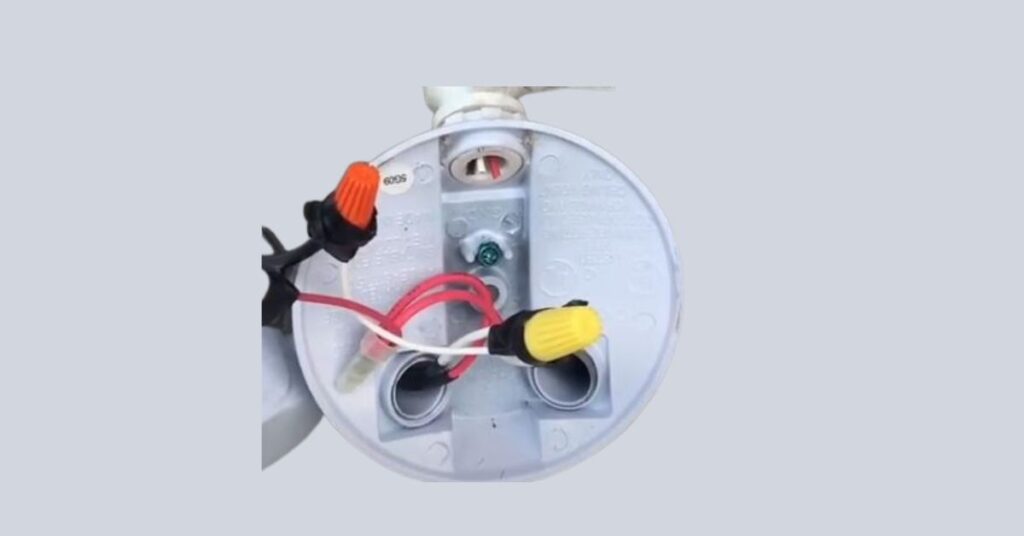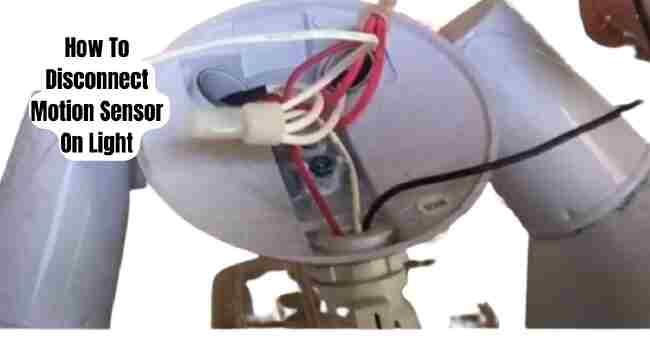Table of Contents
Do you wish to know how to disconnect motion sensor on light? Yes, as homeowner you can disconnect motion sensor on light by yourself without electrician.
There are situations where you need to override or disable the motion detection function, such as to troubleshoot erratic activation or to keep lights on permanently at night.
I ran into this problem myself trying to adjust my home’s new outdoor security lights. The constant triggering was driving me crazy!
In this guide, I will explain in simple steps how to safely disconnect the motion sensor on any standard outdoor lighting fixture.
You’ll learn how to locate the right wires, make the disconnection, and restore power so the light remains on.
With a few basic tools and safety precautions, you can take control of bothersome motion sensing lights.
An Overview of Motion Sensor Lights
Motion sensor lights are a popular type of outdoor lighting that turn on automatically when motion is detected in the coverage area.
They are commonly installed on home exteriors, garages, driveways, and other outdoor spaces. Motion sensor lights provide several benefits:
Convenience – They illuminate walkways, entries, and yards automatically at night without you having to turn them on manually or remember to turn them off. The light activates on demand when needed.
Security – By turning on suddenly when movement is detected, motion sensor lights can startle intruders and deter criminal activity around the home. The illumination also allows homeowners to see clearly at night.
Energy Savings – Motion lights conserve electricity by only turning on when activated by motion. They stay off otherwise.
This is more efficient than lights that are on all night. Most motion sensors also have timers that turn off the light after a set duration when no more motion is detected.
However, there are some scenarios where homeowners may want to override or disconnect the motion detector on these lights:
Malfunctioning Sensor – If the motion sensor is faulty, it may activate erratically or not turn on at all when it should. Disconnecting the sensor will allow the light to operate normally until the sensor can be fixed or replaced.
Constant Activation – Excessive motion sensor triggering can be annoying, like when a light constantly turns on due to branches moving or small animals running through the yard.
Disabling the sensor results in the light staying on without the bothersome on/off cycling.
Scheduled Lighting – You may want lights permanently on for set blocks of time, like every night from 6pm to 1am. Overriding or disconnecting the motion detector allows for scheduled operation rather than motion activation.
Troubleshooting – When trying to diagnose motion sensor issues, it can help to bypass the sensor temporarily to test the light and wiring. This determines if the problem is with the sensor or other components.
Permanent Operation – In some cases, homeowners may choose to convert motion lights to regular lights by removing the sensor functionality permanently. This requires disconnecting the wires.
Whatever your unique situation, this guide will walk through the steps for safely disconnecting or overriding the motion sensor on common outdoor security lights.
I’ll provide direction on exactly how to locate the correct wires and detach the sensor so the light stays on constantly or to your own customized schedule.
The good news is that on most basic motion sensor lights, disabling or disconnecting the sensor is a relatively straightforward process, as long as proper safety precautions are taken.
But before we dive into the step-by-step directions, let’s look at a quick overview of how motion sensor lights work when operating normally.
How Do Motion Sensor Lights Work?
Motion sensor lights have two main components – the lamp or lighting fixture itself and the motion sensor.
The lamp can be any ordinary outdoor lighting fixture equipped with a motion detector module.
The motion sensor is the key element that distinguishes these security lights. This sensor can detect when a person, animal, or object moves within its coverage range.
The detection triggers the lamp to instantly turn on.
Here’s a simple explanation of the operating sequence:
- Motion is detected in the area lit by the lamp. This could be someone walking up to a door, a car pulling into a driveway, an animal darting across the yard, or branches blowing in wind.
- The motion sensor picks up this activity via passive infrared (PIR) technology. PIR sensors can detect the difference between infrared radiation emitted by background objects versus that of a moving warm body.
- When motion is detected, the sensor sends an electrical signal to the circuitry in the lamp housing to activate the light.
- The light turns on when the motion is first sensed. It stays illuminated for a set duration known as the time delay. This is usually adjustable, often between 5 seconds to 15 minutes.
- If motion is detected again during the time delay, the sensor will restart the timer and keep the light on. This prevents the light from turning back off immediately after activation.
- Once the time delay elapses with no more motion triggers, the sensor signal causes the lamps to switch back off.
Now that you understand the function of motion sensor lights, let’s get into how to go about disconnecting or detaching the motion detector on a typical outdoor fixture.
5 Step-by-Step Guide to How To Disconnect Motion Sensor On Light
Now that you understand the basics of how motion sensor lights work, we can dive into the details of how to detach and disable the motion detection sensor.
This will allow the light to remain on without reverting to motion activation mode.
The general process involves:
- Turning off power to the light at the circuit breaker
- Removing the motion sensor housing to access the wiring
- Identifying and disconnecting the specific motion sensor wires
- Bypassing or removing the sensor module completely
- Restoring power and testing operation
I’ll go through each step in detail, including safety tips and photos for illustration. Let’s get started!
Turn Off Power to Light at Breaker Box
The first and most crucial step is to cut power to the motion sensor light by turning off the correct circuit breaker.
Never attempt to disconnect any wiring on a light fixture while the power is still on! Doing so risks dangerous electric shock.
To turn off power:
- Locate your home’s main circuit breaker box, usually in the basement, garage, or utility room. It will consist of a panel of circuit breaker switches.
- Identify the specific breaker controlling the power supply to the motion light you want to modify.
- Breakers are typically labeled, so look for one indicating outdoor lighting, exterior plugs, garage lights, etc.
- If no labels, you may need to flip breakers one by one while checking if the power goes off at the motion light.
- Once you’ve confirmed the correct circuit breaker, flip it fully to the off (O) position.
- To be safe, turn the light switch on to verify power is cut and the motion light does not turn on.
Here are some photos of a standard circuit breaker box panel and close-up of a breaker switch in the ON and OFF positions:
With the power disconnected, you can now safely access the wiring and motion sensor.
Remove Motion Sensor Housing from Light
The next step is to take off the cover of the motion sensing light housing in order to get to the internal wiring and motion sensor module.
The specific removal directions can vary slightly based on the exact light fixture model. But in general, you’ll want to:
- Locate any screws, latches, or clips on the exterior housing and remove them. These are often at the base of the light assembly.
- Gently pull off the housing cover once unfastened. Some covers lift off, while others hinge open.
- If needed, detach any wiring connectors between the housing and the backplate or mounting bracket. This allows full removal.
Here are some tips for different motion sensor light housing types:
- Wall or ceiling mounted – Remove the mounting plate first by taking out attached screws. This lets you detach the light housing from the junction box.
- Flood lights – These typically have hinged covers held in place by adjustable screws. Loosen the screws and swing the cover open.
- Security spotlights – Spotlights come apart in two halves joined by clips. Unclip the trim ring and remove screws to take off the front half.
Once you have the housing open, you’ll see the motion sensor module mounted inside, often on the rear of the cover. Now we can move onto locating the specific wiring to disconnect.
Locate and Disconnect Motion Sensor Wires
With access to the interior wiring and motion sensor, it’s time to identify and detach the correct wires controlling the motion detection function.
Let’s cover some basics about motion sensor light wiring:
- The main power supply cable will come into the fixture housing from the electrical junction box. This provides the live current to activate the light.
- Inside the housing there will be several wiring connectors between the power cables, lamp, and motion sensor module.
- The motion sensor wires are typically a different color than the main power wires, such as red/white compared to black/white.
- There can be 2-3 wires connected to the sensor that control the automatic activation.
The goal is to locate these motion sensor wires and detach them.
Use caution – never allow disconnected wires to touch each other or other components when the power is restored!
Here are the steps to disconnect sensor wires:
- Identify the wiring from the motion sensor – this is bundled separately from the main power cables. You’ll want to isolate and disconnect these wires.
- Take note of where each sensor wire is connected. Use a permanent marker to dab each wire terminal for reference when re-connecting later.
- Carefully remove the wire connectors or twist-caps joining the sensor wires to other cables. A needle-nose pliers or small screwdriver can help pry off the wire nuts.
- Once detached from other wiring, use electrical tape to wrap up each disconnected motion sensor wire separately. This prevents accidental contact when power is restored.
Some tips for motion sensor wire colors:
- The sensor activates when both wires have power – if either is disconnected, it disables the sensor.
- Common colors are red for power and white for neutral/ground. Sometimes a yellow third wire is present.
Here is a wiring diagram as an example:

And photo of detached motion sensor wires:
Now that the motion sensor wires are removed from the circuit, the light will stop reacting to motion activation. But we still need to bypass the sensor or the light may not turn on at all.
Bypass Motion Sensor Function
With the sensor wires detached, there are a couple options for bypassing or disabling the motion sensor completely:
A) Connect sensor wires together
- This essentially creates a closed circuit to permanently activate the light.
- Twist the red and white sensor wires together with a wire nut.
- The light will now stay on regardless of motion.
B) Install manual override switch
- Add a basic on/off switch near the motion sensor light.
- Connect one sensor wire to each switch terminal.
- Flipping the switch will manually activate the light by closing the circuit.
C) Remove motion sensor module
- Unscrew and detach the sensor component from the housing.
- Twist the remaining power supply wires together with a wire nut.
- The light will function normally, minus the motion activation.
Here’s a quick comparison of the bypass methods:
| Method | Pros | Cons |
|---|---|---|
| Connect sensor wires | Simple Leaves sensor intact | No control of light |
| Add switch | Allows manual control | More complex wiring |
| Remove sensor | Fully eliminates sensor | Cannot reactivate sensor |
Choose the bypass method that makes the most sense for your situation. Now we’re ready for the final step – restoring power and testing operation.
Restore Power and Test
Once the motion sensor is fully disconnected or bypassed, we can complete the project by:
- Turning power back on at the breaker box.
- Verifying normal light operation without motion activation.
- Troubleshooting any issues.
Here are the steps to restore and test:
- Return to the main circuit breaker panel and flip the circuit breaker controlling the motion light back to ON.
- Go to the light fixture and flip the wall switch to test.
- The light should turn on and remain on continuously without reverting to sensor mode.
- If the light does not turn on, recheck your wiring connections. One of the modified sensor wires may have come loose.
- If the light still operates in motion activation mode, check that both sensor wires are fully disconnected from the circuit.
- Adjust or replace the bypass switch/wires if needed to get the desired constant operation.
With the successful restoration of power, you should now have a perfectly functioning outdoor light without any motion sensor triggers. Just normal manual control and continuous illumination.
Alternative Methods for Overriding Motion Sensors
The full disconnection process above is the most thorough way to convert a motion sensing light into permanent operation.
However, there are also some alternative options for overriding or disabling the motion activation in various ways:
Adjust Sensitivity Setting
- Many motion sensors have a sensitivity adjustment dial allowing you to control the detection range.
- Turning this all the way down may prevent minor motion from triggering activation.
Change Timer Duration
- Increase the light time delay setting to 30 min. This will keep the light on for longer periods once activated.
Install Light Blockers
- Strategically placed barriers can block the sensor from detecting movement and activating.
Smart Lighting Control
- New WiFi-enabled smart lights can override motion settings remotely.
- Allows turning off motion detection from an app without wiring changes.
These methods allow you to maintain the motion sensing functionality for future use. The tradeoff is less reliability in preventing unwanted triggering.
Fully disconnecting the sensor wires is best for permanent deactivation.
Safety Tips and Precautions
Let’s recap some important safety reminders when working on installing or modifying motion sensing lights:
- Always turn OFF power at the breaker before doing any wiring work. Never disconnect wires while live.
- Use a non-contact voltage tester to double check the power is off.
- Follow proper protocols for containing disconnected wires so they don’t touch each other or other components.
- Only restore power once all wiring connections are complete and contained safely.
- Use a sturdy non-conductive ladder to safely access the light fixture.
- Wear rubber-soled shoes and gloves as an extra precaution against accidental shock.
- Ensure all wire connectors and housing components are securely re-attached before restoration.
- Call a professional electrician if you have any doubts or unsure about the correct modification procedures. Safety first!
Proper handling and containment of the disconnected motion sensor wires is crucial to prevent dangerous shorts or sparking when power is restored.
Take it slow and double check your wiring work. I know this may seem daunting at first, but once you complete the process successfully, you’ll have a real sense of home improvement achievement!
Frequently Asked Questions
How Do I Disable Motion Sensor Lights?
There are a few options for disabling motion activation:
- Turn the motion sensor dial to off or the lowest sensitivity setting. This prevents minor motion from activating the light.
- Adjust the light timer duration to the minimum setting (often around 5-10 seconds). This will limit illumination periods.
- Block the motion sensor view using tape, cardboard, or other barriers to prevent motion detection.
- Fully disconnect the internal motion sensor wiring as described in this guide. This permanently deactivates the motion functionality.
Can You Remove A Motion Sensor From A Light?
Yes, it is possible to remove the motion sensor module from a light fixture housing in order to convert it to a standard non-motion sensing light. The process involves:
- Turning off power to the light at the circuit breaker.
- Opening the light housing and locating the motion sensor component.
- Disconnecting the wiring to the motion sensor.
- Removing the sensor module from the housing.
- Capping off unused wiring and restoring power.
How Do You Convert A Motion Sensor Light To Regular Light?
To convert to a regular light, you’ll need to remove or bypass the internal motion sensor using one of these methods:
- Remove the motion sensor module and connect the power supply wires directly.
- Disconnect the motion sensor wires and splice them together to create a closed circuit.
- Install a manual override switch to control power to the light fixture.
All options involve gaining access to the interior wiring and permanently disabling the motion detection function.
How Do You Remove A Motion Sensor From The Ceiling?
For ceilings, the process is very similar:
- Shut off power at the breaker.
- Remove the ceiling light fixture housing to expose wiring.
- Detach and cap off wires leading to the sensor.
- Unscrew and remove the motion sensor module mounted inside.
- Seal up any holes left from the sensor mount.
- Replace the light fixture housing.
Do Motion Sensor Lights Use Electricity When Off?
Motion sensors use negligible electricity when the lights are off and not detecting motion. They draw a small current to power the sensor electronics, usually around 1-3 watts.
Newer LED motion lights use <1 watt. So they do use a tiny amount of standby power, but save energy overall by powering off when no motion is detected.
How Do You Remove A Motion Detector?
To remove a motion detector, you will need to:
- Turn off electrical power to the detector at the breaker panel.
- Remove any cover plates, housings or fixtures hiding the detector.
- Locate the mounting bracket and small wires connected to the detector.
- Disconnect the attached wires and unscrew the detector from its mounted bracket.
- Place a cap over the end of any disconnected wires.
- Patch up any holes and replace covers.
How Do You Beat Motion Sensors?
Aside from fully removing them, there are some tricks to beating motion sensors:
- Slow, smooth motions can prevent detection. The sensors detect rapid movement better than subtle motions.
- Wear a moving thermal blanket to hide your body heat signature. This can confuse PIR sensors.
- Block the sensor’s field of view with tape, cardboard or another barrier.
- Use an infrared LED light to overwhelm and blind the sensor.
- For outdoor lights, point branches or plants to trigger the sensor then block its view when on.
What Are The 3 Settings On A Motion Sensor Light?
Most motion sensing lights have three key adjustability settings:
- Sensitivity – Controls the detection range and how much motion is required to activate.
- Time Delay – Sets how long the light stays on after motion is detected. Ranges from 10 seconds to 20 minutes.
- Light/Dark Mode – Tells the light to activate based only on motion (light mode) or motion + darkness (dark mode).
Adjusting these settings can help reduce unwanted activations.
Why Is Motion Sensor Light Staying On?
A motion light staying on constantly is typically caused by:
- Sensor being blocked: Something obstructing view of the detector.
- Bad sensor alignment: Sensor pointed at busy areas with constant motion.
- High sensitivity setting: Detects any tiny motion including branches/debris movement.
- Continual activation resetting the time delay. Frequent motions prevent the light from ever turning off.
- Faulty sensor malfunctioning and staying on. May need replacement.
How Do You Turn Off A Motion Sensor Switch?
For motion sensing switches that control lights, you can override the motion activation by:
- Toggling the switch off and leaving it in the off position. But the light must be turn on manually.
- Setting the time delay to the shortest setting (usually around 10 seconds).
- Disconnecting the switch wires and installing a regular light switch instead. This completely disables the motion detector.
How Do I Turn Off Neighbors Motion Light?
To stop a neighbors’ troublesome motion security light:
- Politely talk to your neighbor about the issue and request adjustments.
- Offer to pay for them to install light blockers that prevent the light from trespassing onto your property.
- As a last resort, legally installed light barriers on your side can block problematic light spillage from their motion detector.
- Avoid any unlawful tampering on their property. Seek mediation if needed.
The best solution is always a friendly conversation and compromise. Hope these tips help resolve any annoying motion sensing lights!
Conclusion
Overriding or disconnecting the motion sensor on an outdoor light may seem intimidating, but as you’ve learned, it can be a surprisingly straightforward DIY project. The key steps are:
- Turning off power to the light
- Detaching and isolating the motion sensor wires
- Bypassing the sensor via one of the described methods
- Restoring power and testing operation
Following proper safety procedures like power disconnection and wire containment is critical. Take your time and don’t skip any precautions.
While a bit more involved than just flipping a switch, the ability to take control of bothersome motion lights provides real practical benefits and security.
No more constantly cycling lights or erratic activations. Just steady, ready illumination on your own terms.




